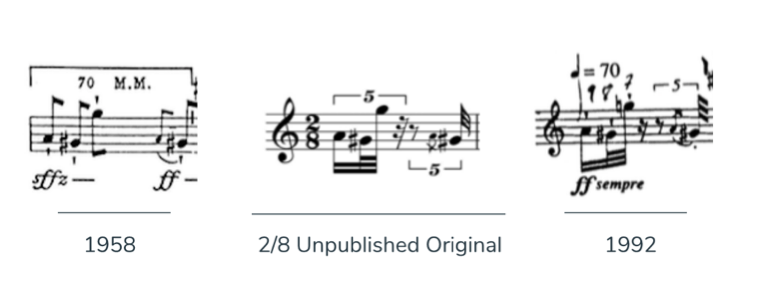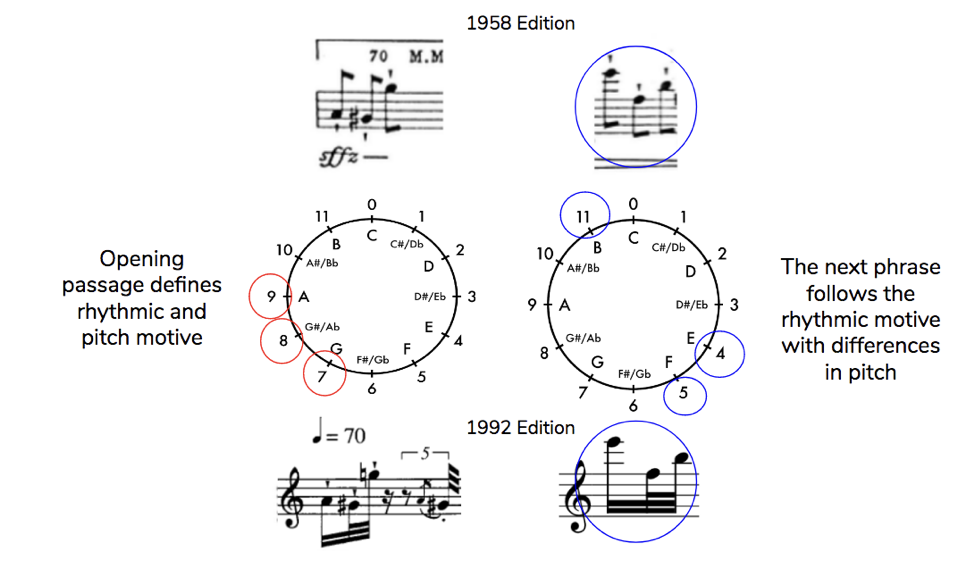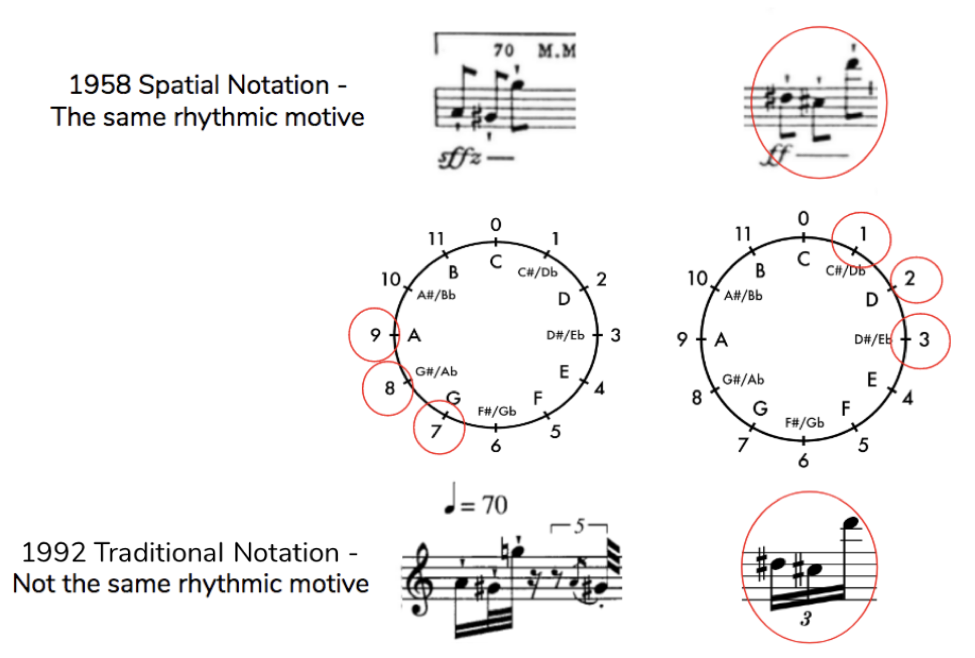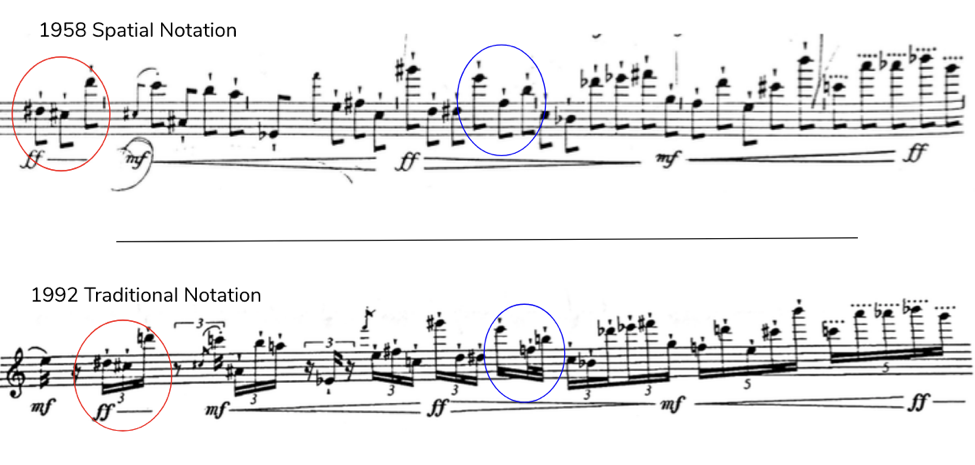Rhythm and Motives in the Two Editions of Berio’s Sequenza I
by Katherine Scholl
Berio’s Sequenza I is a staple of the flute repertoire, and a piece I had become increasingly interested in studying throughout the past few years. After taking a course on post-tonal music and analysis during my junior year, I began to develop a better appreciation for music written outside of the boundaries of specific meter and key signatures, and enjoyed learning how to analyze post-tonal music by pitch and interval patterns. Last summer I attended the National Flute Association’s annual convention, and had the opportunity to browse a large collection of sheet music at the exhibits. My eyes immediately became fixated on the Berio flute Sequenza, and I decided it would be an interesting piece to learn, especially after having gained a better understanding of the theory behind post-tonal music.
As this piece has been widely studied since 1958, I knew in approaching this project that I wanted to find a way to bring my own insight to the piece that went beyond a simple analysis. With this in mind, I chose to center my project on the differences between the two published editions: the original, published in 1958 in a more visual style called spatial notation, and a 1992 edition written in traditional notation. While the notes in both editions are the same, the vastly different notational styles highlight different motivic elements. This in turn suggests different performance and listening strategies for what seems to be the same piece. At first glance, Luciano Berio’s Sequenza I seems to be without a clear melody. The listener will hear long and short pauses between sections, and notes and rhythms that move in unexpected, non-tonal directions. Upon closer study and examination of the piece, however, one can find that it is defined by recurring motivic elements. Example 1 shows the opening three notes as notated in the 1992 edition.

These notes create a distinctive motive, which involves both pitch and rhythm. The opening three pitches (A, G-sharp, G) seem to spell out a descending chromatic scale, but the last of these three pitches is in the octave above. Berio uses this recurring three-note chromatic motive throughout the piece, even though the rhythm may appear different in later instances, in the 1992 edition. With this in mind, the second significant motivic element introduced in the same first three notes is the 16th and two 32nd notes rhythm, or long-short-short. Berio uses this rhythm throughout the piece, but its distinctive rhythmic profile is only evident in the 1992 edition, as we will see.
Berio’s Sequenza for flute was written in 1958 for Italian flutist Severino Gazzelloni. Before publication, the complex notation and rhythms were written in a style that proved to be too difficult for many flutists to play. In an attempt to make the music on the page easier for flutists to read, Berio published the first edition of the piece using spatial notation, a technique of denoting length of notes and rests by physical space and distance on the page (see Example 2). This publication was successful, as flutists could understand and perform the piece without having to count overly complex rhythms. Berio thus became a pioneer of spatial notation in the flute repertoire.

However, Berio thought that flutists were taking too many liberties in rhythm in the spatial edition, as he originally wrote the piece with extreme rhythmic specificity. For example, as flutist Aurèle Nicolet was preparing to record the Sequenza, Berio sent him a notated version of the opening line in its original 2/8 time to demonstrate a more proportionally consistent way to play the rhythms. As a solution to frequent errors in rhythmic and timing details by performers, a new version of the piece was published in 1992, notated in traditional form by Berio’s assistant Paul Roberts and approved by Berio (see Example 3).

In my study, I wanted to find a way to analyze the exact differences between the editions. The most objective way for me to do this was to create a digitally notated version of each edition, using music notation programs and digital audio workspaces (see Video Examples 1 and 2). For the 1958 edition, I used a metronome in the background to place the notes spatially between each beat. While placing the notes exactly as rhythmically notated, I realized that playing the 1992 edition with the perfect rhythmic specificity of a computer would not allow for nuances in melodic shaping, so that the precise rhythmic notation caused the digital version to sound more choppy and abrupt than the more fluid 1958 edition.
With the two editions in mind, some of the motives present themselves more clearly in one edition than the other. Example 4 illustrates the opening motive of the piece in both editions; the motive has a more distinct rhythm in the 1992 edition. This allowed me to conclude that the 1992 traditional edition is able to be more precise about defining the rhythmic motives. However, by limiting the motive to this exact rhythm, the performer of the 1992 edition misses out on more locations where the pitch motive appears. Without a pitch and interval class analysis of the 1992 edition, Berio’s motivic style of writing would not have been clear to me as a performer.

To illustrate this, Example 5 compares two instances of a motive in the two editions. In the 1992 edition (Example 5, lower part) the opening three notes are clearly defined as starting on a 16th note followed by two 32nd notes. As heard in the audio examples, this is a more specifically defined rhythm. In this new edition, this rhythm clearly returns in the middle of a long phrase (Example 5, lower part on the right). However, in the original publication (Example 5, upper part) there is no indication that this is a recurring motive. The rhythm is not distinctive and we no longer see the descending chromaticism of the opening line. Thus, the rhythmic motive is evident in the 1992 edition, and not in the original 1958 edition.

In contrast, the 1958 edition includes a three-note motive with a similar pitch class pattern to the opening three notes (see Example 6, upper part). In the 1992 edition, it is written as a triplet, so it does not present itself as the same motive (Example 6, lower part). However, with the absence of rhythmic specificity in the 1958 edition, we are more likely to notice that the pitches create a similar tone cluster to the original example.

The two circles highlight the pitches used in both examples, with each of the three notes circled on clockfaces. Both instances create tone clusters without gaps, demonstrating that regardless of the octave being used or the order that the notes appear in, the pitches used are right next to each other on the scale, creating the tone clusters. Example 7 shows where the two previous examples occur in the context of the larger phrase, in both editions, with the circled motives appearing as the motives explored in both Examples 5 and 6.

These examples show how distinct rhythmic and pitch motives emerge from the two editions. Several essays have been written regarding the differences between both editions. Cynthia Folio and Alexander Brinkman sought to identify the differences in eleven performances between the editions by conducting a computer analysis of precise timings from performers playing from either the 1958 or 1992 edition. Their findings showed that only one of the performers playing off of the old edition played the opening three note motive with the same rhythm as the 1992 edition, confirming my theory that the 1992 edition allows for a greater emphasis on the rhythmic aspect of the motive (Folio, Brinkman, 2007). Referencing the Folio article, Cibele Palopoli adapted the layout of the 1958 edition to fit under the 1992 edition for selected visual examples in order to highlight the biggest similarities and differences between the editions. Palopoli reveals that while the 1992 edition is more rhythmically precise, the fermatas in this edition are denoted by duration of seconds which is less precise than counting the bars containing the longer notes with a metronome in the 1958 edition (Palopoli 2013). These examples demonstrate that each edition has its own opposing benefits and drawbacks, leading me to conclude that it would be beneficial to the performer to study both editions at once. I can conclude that by combining a study of both editions, the performer can have a better understanding of Berio’s use of both pitch and rhythmic motives.
An emphasis on pitch class or rhythm will certainly create a different experience for the performer and audience, depending on which edition is being performed. The 1992 edition is more rhythmically precise, similar to Berio’s original intentions in his composition; however, it is still an imperfect form of notation as much of the piece is written in confusing tuplets. (This is why it written spatially in the first place.) While the rhythmic motifs are easier for the performer to identify in the new edition, it is easier for the performer to focus on the notes being played as the rhythms are simpler to play in the 1958 spatially notated style.
The topic of which edition is better to use in studying and playing Berio’s Sequenza is a polarizing one among flutists. Many performers grew up learning and studying the original edition, and have developed their own interpretations that they are very protective of. For example, flutist Helen Bledsoe observes in her blog that she still continues to play from the old edition as it has been in her memory for 20 years of study, although she appreciates the clarity in timing that the new edition provides. Additionally, in the YouTube video series “Fluting with Paula,” Paula Robison says that she views the 1992 version as a wonderful study guide in learning how to play the exact rhythms that Berio imagined, but still prefers to read from the original piece in performance. For Robison, the older edition is more familiar and more appealing visually. I have had the opportunity to approach both editions with a fresh eye and ear, and it has been valuable to learn from both versions simultaneously. Due to Berio’s different treatment of motives in both editions, with the spatial notation favoring pitch and interval aspects and the traditional notation favoring rhythmic aspects, the two editions seem almost to be different pieces. However, if studied as companions to each other, they make up two puzzle pieces to realizing Berio’s complete intent for a performance of his Sequenza I.
Works Cited
Folio, Cynthia, and Alexander R. Brinkman. 2007. “Rhythm and Timing in the Two Versions of Berio’s Sequenza 1 for Flute Solo: Psychological and Musical Differences in Performance.” In Berio’s Sequenzas: Essays on Performance, Composition, and Analysis. Burlington, VT: Ashgate.
Folio, Cynthia. 1996. “Luciano Berio’s Revision of ‘Sequenza’ for Flute: A New Look and a New Sound?” The Flutist Quarterly 21/2: 43-50.
Dorough, Aralee. 2000. “Performing Berio’s Sequenza.” Flute Talk 19/7: 11-13.
Palopoli, Cibele. 2013. “Comparative Rhythmic Study Between Editions of Sequenza I for Solo Flute by Luciano Berio.” In Principles of Music Composing: The Phenomenon of Rhythm. Vilnius: 13th International Music Theory Conference, Lithuanian Academy of Music and Theatre and Lithuanian Composers’ Union.